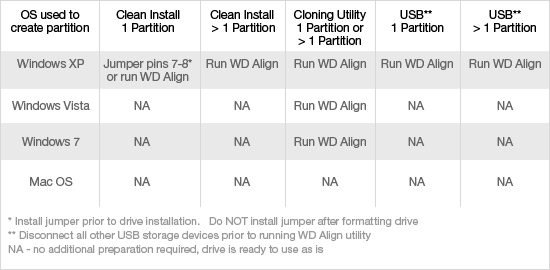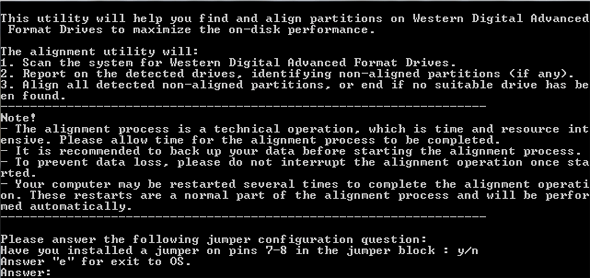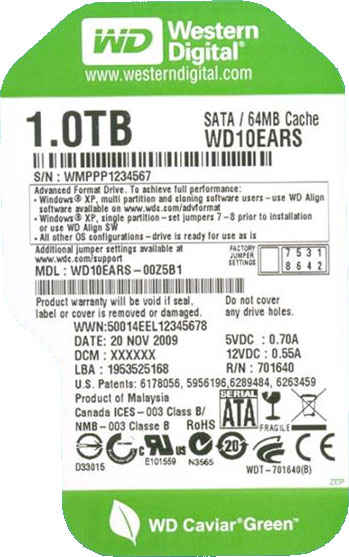Western Digital’s Advanced Format: The 4K Sector Transition Begins
by Ryan Smith on December 18, 2009 12:00 AM EST- Posted in
- Storage
What Operating Systems Are Affected
Now that we’ve dealt with what 4K sectors are, why Western Digital and other drive manufacturers are switching to them, and what the potential pitfalls of 512B emulation are, we can look at the specific cases where there are potential problems.
The big problem is that while the first work on 4KB sectors started in 1998, it wasn’t until after the launch of Windows XP that the matter came to a head. As a result the 5.x versions of Windows (2K, XP, 2K3, WHS) have no concept of 4KB sectors. Even though all operating systems will be seeing 512B sectors through the use of emulation technology on the drive controller, out of Windows only Win 6.x (Vista, 2008, Win7) and later have been programmed to take in to account the alignment issues we mentioned earlier. Win 5.xx in particular has a nasty habit of starting the first partition at LBA 63, which is 1 512B sector misaligned from a 4K sector boundary. In essence, the issue is that Win 5.x will always create a misaligned first partition and will have poor default performance as a result.
Although Win 5.x is the primary victim here, other versions of Windows can also be affected in edge cases. Along with the need for 4K-aware operating systems, drive imaging software needs to be 4K-aware. Otherwise such imaging software may inadvertently create misaligned partitions too. As such, Win 6.x is also affected by alignment issues when imaging software is used, as some (and perhaps all?) imaging products currently available will write misaligned partitions and/or clusters.

Notably, Linux and Mac OS X are not affected by this issue. Western Digital has tested both of these operating systems, and officially classifies them as not-affected. Ultimately we suspect that if you went back far enough you could find older versions of these OSes that are affected, but unlike Win 5.xx, there’s not a significant legacy user base to worry about. Along these lines, Linux and Mac OS X drive imaging products are similarly unaffected. In their testing, imaging tools such as SuperDuper didn’t run in to any alignment issues, so Linux and Mac OS X users are not affected in any way by 4K sectors. It’s only Windows and Windows imaging products that are affected.
In order to solve the misalignment issue, Western Digital is offering two solutions. The first solution for correcting misaligned partitions is specifically geared towards Win 5.x, and that is an option on the drive itself to use an offset. Through the jumpering of pins 7 and 8 on an Advanced Format drive, the drive controller will use a +1 offset, resolving Win 5.xx’s insistence on starting the first partition at LBA 63 by actually starting it at LBA 64, an aligned position. This is exactly the kind of crude hack it sounds like since it means the operating system is no longer writing to the sector it thinks its writing to, but it’s simple to activate and effective in solving the issue so long as only a single partition is being used. If multiple partitions are being used, then this offset cannot be used as it can negatively impact the later partitions. The offset can also not be removed without repartitioning the drive, as the removal of the offset would break the partition table.
The second method of resolving misaligned partitions is through the use of Western Digital’s WD Align utility, which moves a partition and its data from a misaligned position to an aligned position. This is the recommended solution for using multiple partitions under Win 5.xx, along with correcting any misaligned partitions generated by imaging software. For that matter we’d consider it the recommended solution for single-partition drives being used under Win 5.x too, as there’s no need to worry about offsets and breaking the partition table.

The utility is available for download from Western Digital’s site, and while it isn’t pretty (it’s a scripted CLI application) it gets the job done. The amount of time needed to run the utility is based on the amount of data that needs to be moved rather than the partition size (it simply ignores empty space), so it’s best to run the utility immediately after creating a partition or installing Windows, as there’s less data to move around.
Unfortunately, at this point the utility also serves as the only way to identify an Advance Format drive without physically looking at it. Looking at the ATA spec, it looks like there’s a provision for asking a drive its native sector size (regardless of 512B emulation) but at this point there’s no such tool beyond the WD Align utility itself. This in and of itself isn’t a big issue, but if you’re a techie that ever finds themselves working on an XP machine with a 1TB+ Western Digital drive, you’ll want to keep an eye open.
The First Drives & The Future
So what are the first Advanced Format drives and when are they due? The first drives will be Caviar Green drives using multiple 500GB platters – so the 1TB, 1.5TB, and 2TB Caviar Green. These drives will be shipping any day now, and can be identified through two different methods: 1) They all have 64MB of cache - the first WD Caviar Green drives to come with that much cache - and 2) They all have EARS in the drive model number, e.g. WD10EARS.

As we stated before, in spite of the benefits of 4K sectors, Western Digital is not pushing these drives as part of any major product launch. Rather they’re going to be quietly trickling in to the marketplace. Expect a price premium at first (as with any other new product) before settling down. We don’t have a drive on-hand to review, but from the fact that this is a low-key launch, WD isn’t painting any expectations of a performance difference, although this will be something to test in the future.
And on that note, expect to see similar launches from everyone else within the next year. The last IDEMA plan called for everyone to have 4K-sector drives by 2011, so everyone should be launching within the next year here. Everyone using 512B emulation is going to run in to the same teething issues with Win 5.x – so while other vendors may handle things slightly differently, ultimately everyone is going to be compensating for Win 5.x in some manner (in case it hasn’t been made clear here, these guys would be ecstatic for Win 5.x to go away quickly).
Farther down the road will be the exposure of 4K-sectors to the operating system itself. Linux and Win 6.x are set (and we believe that Mac OS X is too), the only limit right now is the desire to do a phased transition to make thing easier for legacy users. Since 4K-sector drives won’t work on Win 5.x at all, drive manufacturers can’t put them on the market so long as there’s a significant legacy base. 2014 – the year that extended support ends for WinXP – looks like a good year to finally complete the move to 4K sectors.










86 Comments
View All Comments
ChuckR - Friday, December 18, 2009 - link
If 4k will not be the standard till 2014(estimate), When will Sata 6.0 be implemented to improve the speed of Read-Modify-Write conditions.I read the Seagate Barracuda runs Sata 6.0, BUT only for outer sectors.
Any word on a total solution for HD's?
pbhj - Friday, December 18, 2009 - link
hdparm tells me "Logical/Physical Sector size: 512 bytes" but this article tells me:Unfortunately, at this point the utility also serves as the only way to identify an Advance Format drive without physically looking at it. Looking at the ATA spec, it looks like there’s a provision for asking a drive its native sector size (regardless of 512B emulation) but at this point there’s no such tool beyond the WD Align utility itself.
So did hdparm just guess ....
GourdFreeMan - Friday, December 18, 2009 - link
No, hdparm just passes along what the drive's controller reports to the kernel. The controller pretends the drive has a 512 byte sector size, even through physically this is not what happens when a write is done by the controller. The same thing already happens with SSDs -- on my Gentoo home server my SSD happily reports:Logical Sector size: 512 bytes
Physical Sector size: 512 bytes
despite pages being far larger than that.
yacoub - Friday, December 18, 2009 - link
Any issues running mixed 4k and 512b drives in the same system? assume the OS (WinXP/Win7) will be able to sort it all out and transferring data from one to the other will occur properly?excalibur3 - Friday, December 18, 2009 - link
It doesn't really make sense to me why they can't release 4K sector drives without the emulation and just write in big letters "For use with Windows Vista and higher" on it? Consumers now need to be careful about getting SATA vs. PATA drive, what is one more specification that they need to be aware of?DanNeely - Friday, December 18, 2009 - link
You're assuming users will have something resembling a clue. WD would get its return dept flooded by XP users reporting defective drives.What they could theoretically do would be to have a jumper setting that changed if they exposed 512b emulation or 4k native sectors to the OS and defaulted it to 512b. This'd work universally out of the box, and would be a trivial fix for the clueful to switch to the optimal mode.
geofelt - Friday, December 18, 2009 - link
If the 4k sector is 10% more space efficient, would that not also also translate into 10% greater data transfer rate.azmodean - Friday, December 18, 2009 - link
If the raw read is the only bottleneck in the system, you might theoretically get that, but in practice I doubt it's the only bottleneck. That is a good point though, there should be some performance improvement from this (particularly with very large reads.)icrf - Friday, December 18, 2009 - link
I have a couple 1.5 TB Caviar Green drives in a software RAID 5 array (Linux, mdadm, 64K stripe). Anyone know if I'd run into compatibility problems if I expanded the array to include my old drives plus a new 4K drive? I know I wouldn't be able to make use of the extra space, but the better error correction would be nice.esandrs - Friday, December 18, 2009 - link
XP/2003 has a disk partition utility that allows setting offsets. I've used it in 2003 for some SAN environments to do partition alignments. It may not be as automated as the WD tool, but it does work on any drive.